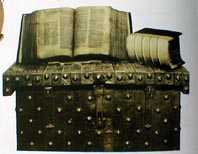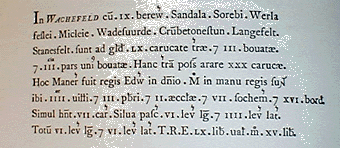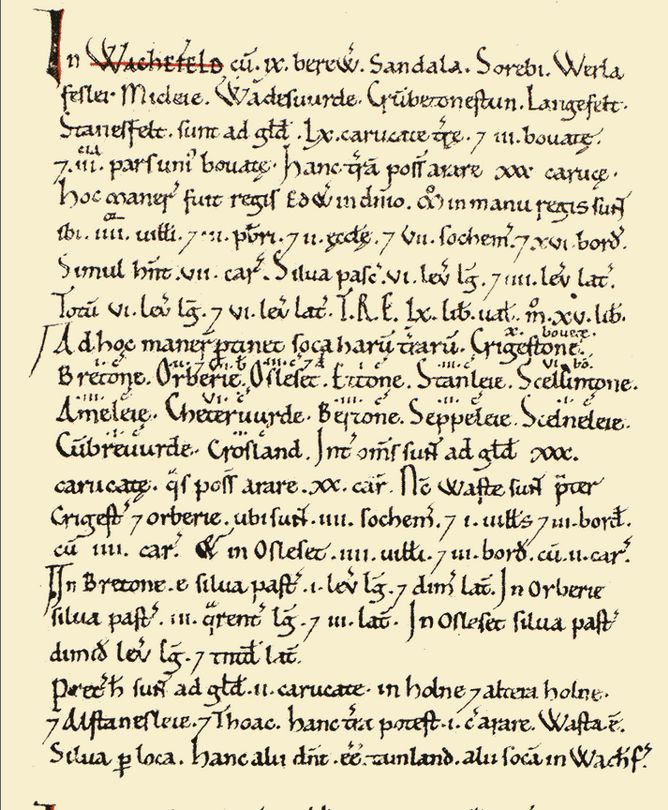
|

|
Carucate [car]- No fixed number of acres*. Probably related to the quality of the land. An area of land that could be ploughed by a team of eight oxen in a year, sometimes called a Ploughland in the North of England, [60-120acres]. Later 2 carucates are said to have made a Knight's Fee.4 A ploughed field was ridged and furrowed. A furrows length was a 'furlong' each ridge was spaced at the distance of one rod [also called a pole or perch] Four furrow lengths or furlongs of ploughed field covered one acre.
Acre = 1 furlong by 4 rods while 4 rods = 1
chain and 1 rod = 5 1/2 yards (possibly the width of
the yoke of a team of oxen
Knight's Fee- 120-240
acres [ i.e. 2 carucates].
Hide- 120 acres
 Virgate - about 30
acres.
Bovate/bo [Oxgang]-
land which could be worked by one ox, one eigth of a carucate i.e.
Virgate - about 30
acres.
Bovate/bo [Oxgang]-
land which could be worked by one ox, one eigth of a carucate i.e.
7.5-15 acres.
Hundred- a sudivision
of a shire, common in southern England.
Wapentake- ["Weapon-take"] is equivalent
to a "Hundred" in southern England.
Domesday mile - 1.5
miles of the more 'modern' mile.
Lat- wide [hence lateral]
League- [lg]
from Latin: Leuge [Celtic: Leuca] commonly equal to 3 'modern' miles.
Lev- long
Tot- whole [total]
Dim- half [probably the
derivation for 'dim-wit' or 'half-wit'.]
Lib- English pound,
£, [probably the origin for £iberty, i.e. money to do what
one likes with, the true meaning of liberty so much espoused today. So money
was at the bottom of it all!]
We can also see where
the symbol lb. for pound weight originated.
Fol- shilling [1/-]
Trae- three
 TERMS:
TERMS:
manedo/manerio/manerium
[maner i.e. manor]- The usual residence of the owner. They may have
been small to very large dwellings.
waste- an area laid
barren during William I's "Harrying of the North" in 1069 and still
agriculturally wasted
seventeen years later in 1086.
T.R.E.- Terra Regis Edwardi, Before 1066,
the land during the reign of Edward the Confessor.
ad gld- taxable land.
bord- bordar, a smallholder.
hb- had
car- ploughs
berew- Berewick, an outlier from the main
manor.
Id eft- that is [i.e.]
past- pasture
possunt/ poss/potest- possible
ptinet- belong
silua- woodland
tenet- tenant, holds from.
taini/teigni- theigns
constable- a castellan, a keeper of a
royal castle, also an officer of a hundred who was responsible for
running a military levy [Late Latin & Old French 1200's stabuli- officer
in charge of the stables, Latin- comes-comrade + stable- homestead or stable.]
ual- value
 |
| Micleie etc 1086 DB original facsimile |
Notes:
* An acre is 1 furlong ['furrow long'] by one chain. One chain
is 22 yards. Eight furlongs constitute one 'modern' mile.
Sources:
1. Pratt, C.T. History of Cawthorne, Davis of Barnsley, 1881.
2.Faull, M. L., & Stinson, M. (Eds.), Domesday Book For the County
of Yorkshire, Phillimore, Chichester,1986.
3. Farley, Abraham, The Domesday Book, 1783, from zincograph by Ordnance Survey, 1861-3.
4. Monasticon Eboracense, p. 440.